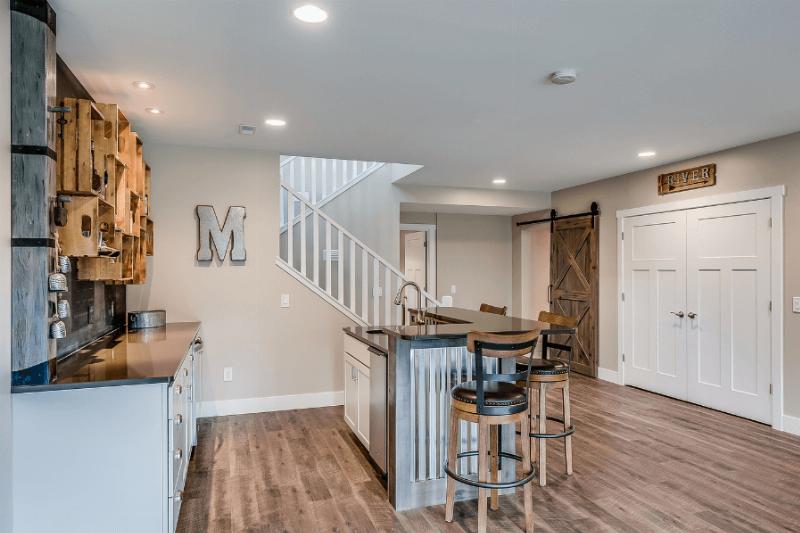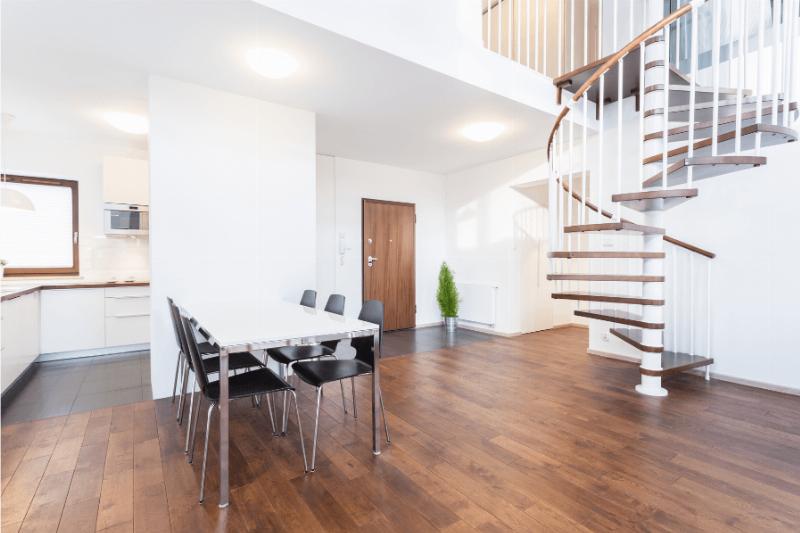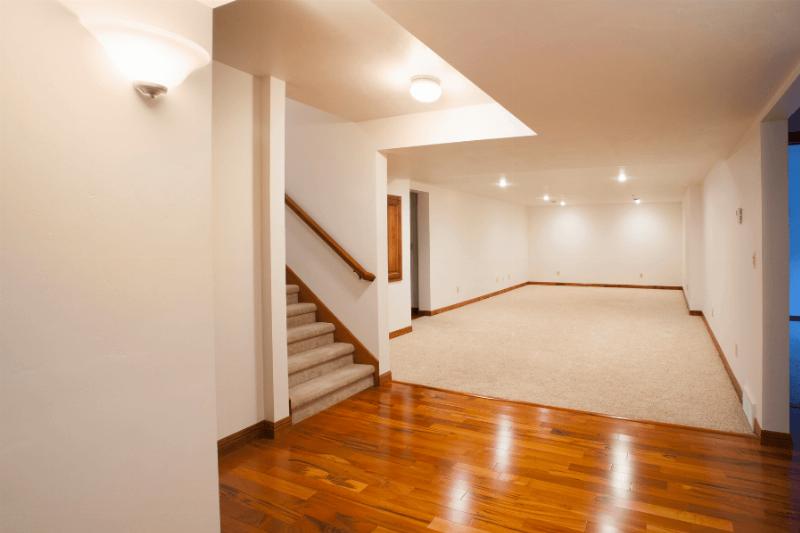Your basement would be a cozy entertainment area, an extra living quarter, or a stylish retreat beneath your feet. However, the route to basement bliss is not without its hurdles, particularly when selecting the right flooring.
There are many factors to consider, like Temperature, moisture, and durability, to ensure the longevity and functionality of flooring.
Beneath the surface, the basement stands strong with sealed, solid concrete built to endure the test of time. However, its raw, chilly demeanor may not invite you to linger. A modernized basement floor is the key to making this space a hotspot for work, play, or pure relaxation. So, let’s give it a makeover.
6 Best Flooring Options for Basements that You Can Explore

When it comes to basement flooring, the options are diverse, but choosing the right one is crucial for durability and style. Here is a list of the best flooring options for basements that you can consider.
|
Flooring Type |
Installation |
Maintenance |
Cost |
|
Vinyl |
Glued-down or floating floors with click-and-lock systems |
Easy |
Low |
|
Ceramic/Porcelain Tile |
Requires flat, level subfloor |
Moderate |
Medium |
|
Laminate |
Click-and-lock floating floors |
Easy |
Low-Medium |
|
Engineered Wood |
Floating floors, DIY-friendly |
Easy |
Medium-High |
|
Carpet |
Professional installation recommended |
Higher |
Variable |
|
Epoxy |
Professional installation recommended |
Low |
Variable |
1. Vinyl Flooring
Vinyl is a common material for basements because of its affordability, toughness, and ability to withstand moisture. Elegant vinyl planks or tiles have outstanding moisture resistance and resemble stone or hardwood.
Concrete can be directly covered with vinyl using an adhesive. Proper preparation, including leveling and crack sealing, ensures a professional finish. Vinyl is practically waterproof, making it a budget-friendly, quick-installation option suitable for high-traffic areas.
- Durability: It is capable of withstanding dents, scratches, and moisture.
- Installation: They can be glued down or installed as floating floors with click-and-lock systems.
- Design options: This flooring is available in many different styles, such as stone and wood.
- Maintenance: Regular sweeping and sporadic mopping make cleaning this area simple.
- Cost: In general, it is less expensive than alternative solutions.
2. Ceramic or Porcelain Tile
Clay, sand, and water are usually combined to create ceramic tiles. They are a popular tile option that has been utilized for many years in residential and commercial spaces, and they might be a wise choice for a basement.
Ceramic tile is a popular choice for flooring because it is typically not very expensive. A wide range of colors, styles, and sizes is available for ceramic tiles.
While ceramic tiles may lose color over time, they are water-resistant and suitable for basements. Porcelain tiles, a denser alternative to ceramic, retain color and are more expensive but offer durability and variety in remodeling.
- Durability: Extremely durable and moisture-resistant, making it suitable for basements.
- Installation: A flat, level subfloor and professional installation is required for best results.
- Design Options: Available in various sizes, colors, and patterns, allowing creative customization.
- Maintenance: Easy to clean with regular sweeping and mopping, but grout may require periodic sealing.
- Cost: This can vary depending on the type of tile chosen and the installation method.
3. Laminate Flooring
At a lesser price, laminate provides the appearance of stone or hardwood. Modern laminate flooring is meant to be moisture-resistant. However, it is only partially waterproof in somewhat damp basements.
Laminate flooring has existed for many years and was developed as a less expensive substitute for hardwood floors. It exhibits durability as it can tolerate high levels of foot traffic.
- Construction: Printed image and protective top layers are layered over a high-density fiberboard core.
- Moisture Resistance: It’s essential to select laminate flooring options for basements because some laminate floors are water-resistant but not waterproof.
- Installation: Click-and-lock floating floors are commonly installed, making them suitable for do-it-yourself installations.
- Design Options: Offers a large selection of designs that mimic the appearance of stone, tile, or hardwood.
- Maintenance: Regular sweeping and sporadic damp mopping make cleaning simple.
- Cost: Usually less expensive than engineered or hardwood wood.
4. Engineered Wood Flooring
Engineered wood, which is composed of several layers that are bonded together, offers more stability and moisture resistance than solid hardwood. It is imperative to select engineered wood that has a moisture barrier. So that you can avoid warping or damage.
Engineered wood is a type of flooring consisting of a plywood core that adds thickness and a thin layer of natural wood on the surface. If you’re looking for something more affordable than solid hardwood flooring, engineered wood is a good option.
- Construction: Made up of layers of plywood or high-density fiberboard sandwiched between real wood veneer (HDF).
- Moisture Resistance: Less prone to damage from excessive moisture exposure than solid hardwood but still resistant to moisture.
- Installation: This DIY-friendly material can be installed as floating floors.
- Design Options: Provides the warmth and beauty of real wood in a range of plank widths, species, and finishes.
- Maintenance: It is advised to mop occasionally with a damp cloth and to sweep frequently.
- Cost: Generally speaking, this is more costly than solid hardwood but less expensive than vinyl or laminate.
5. Carpeting
For basement floors, carpet tiles or low-pile carpeting can be good choices, particularly in locations where moisture is less of an issue. To guard against moisture, select carpet materials that are resistant to it and add a waterproof underlayment or vapor barrier.
Consider carpet tiles for simpler upkeep and replacement in the event of water damage.
- Construction: Fibers attached to a backing material made of synthetic materials.
- Moisture Resistance: Some fibers are inherently resistant; use moisture-resistant padding and proper subfloor preparation.
- Installation: Professional installation recommended.
- Design Options: Wide range of hues, patterns, and textures.
- Maintenance: Regular vacuuming, occasional spot cleaning, and deep cleaning.
6. Epoxy
The concrete floor of the basement can be updated by directly applying epoxy. Since epoxy is a waterproof basement flooring solution, it’s one of the best choices for homes with moisture-related problems.
Epoxy can aid in sealing and protecting the underlying surface, even though concrete is a porous material susceptible to water damage. Numerous hues, designs, and textures are available for epoxy basement floor treatments.
- Construction: Mixture of resin and hardener for a seamless, long-lasting surface.
- Moisture Resistance: Exceptional moisture resistance, ideal for basements.
- Installation: Professional installation is recommended for best results.
- Design Options: Solid colors, metallic effects, decorative flakes, custom designs.
- Maintenance: Little upkeep, occasional mop with mild detergent, and regular sweeping.
- Durability: Resilient, impervious to abrasion, chemicals, stains, and impacts.
- Cost: Varies based on factors like size, surface preparation, and design complexity.
What Should I Consider When Finishing My Basement Floor?
When it comes to installing new flooring in your basement, there are several essential factors that you should take into account. Here are some crucial questions to ask yourself:
- What is the current condition of the basement floor?
- Is it a dry area, or do you have flooding problems annually?
- Is the floor prepared for installation and level?
- What will you be doing with your basement?
- Which type of space—one that will be heavily used and trafficked or one that is comfortable and den-like?
To choose the kind of flooring you want to use, you must consider these factors.
Things to Check Before Choosing Basement Flooring

Before settling on basement flooring, several essential factors must be considered. These have a significant impact on the functionality and comfort of the space.
1. Moisture Resistance
First and foremost is moisture resistance. Ensuring that chosen materials can withstand potential moisture is paramount for long-term durability.
2. Durability
The next factor is to analyze the durability of the flooring. It is crucial, particularly when considering the specific use of the basement. A playroom for kids may demand different flooring than a space designated for a custom bar. Matching the durability to the intended purpose ensures a lasting investment.
3. Comfort Level
Comfort is another crucial factor, given the versatile uses of basements. Basements can be utilized for various purposes, such as a custom bar, home theatre, or additional living space. Select the type of flooring that best suits your needs in terms of comfort.
4. Warmth
Temperature plays a role, too. As the basements often have a colder foundation, selecting flooring that contributes to warmth is essential. Whether opting for epoxy or ceramic tile, considering the potential coldness of the floor adds an extra layer of comfort to the decision-making process.
Considering Basement Remodeling? Explore Our Expert Services
If you’re planning a basement remodel, Smart Remodeling LLC can help you. We’re experts in turning dull basements into cool spaces. Whether you want a cozy movie room, a fancy bar, or just an extra hangout spot, we’ve got you covered.
For over a decade, Smart Remodeling LLC has been at the forefront of providing top-notch renovation services in Houston.
From choosing floors that can handle spills to creating a nice vibe, our team will take care of everything. Don’t let your basement go to waste – let’s make it amazing together! Reach out to Us today.
Wrap Up
In conclusion, selecting basement flooring involves weighing factors such as moisture resistance, longevity, comfort, and maintenance. The best choice depends on personal preferences, budget, and the intended use of the space, ensuring improved usability, comfort, and aesthetics for years to come.






